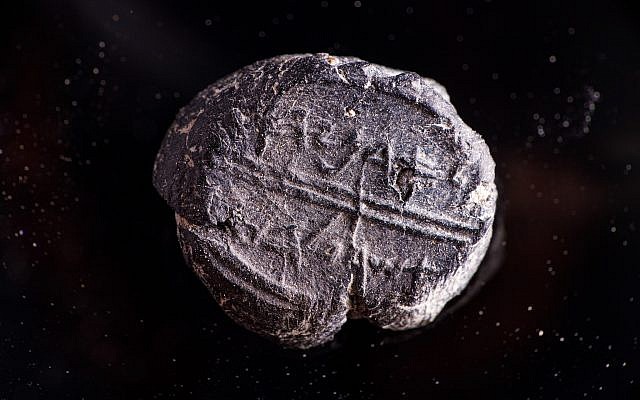Tiny First Temple seal impression found with name of Bible-era royal steward

A minuscule 7th century BCE clay sealing reading “Belonging to Adoniyahu, the Royal Steward,” was recently discovered in the City of David’s sifting project.
In earth excavated from the foundations of the Western Wall under Robinson’s Arch in 2013, a national service volunteer some three weeks ago unearthed the one-centimeter inscribed letter sealer bearing the ancient Hebrew name of a character found several times in the Hebrew Bible, Adoniyahu, literally, “The Lord is my Master.” (In English translations of the Bible, the name is written Adonijah.)
According to archaeologist Eli Shukron, this inscription is unique and “of utmost importance.” The role of the Royal Steward (Asher al Habayit), he said, appears several times in the Bible and is used for the highest-level minister in the royal court. For example, the title of Royal Steward was used in the Book of Genesis for Joseph’s high-powered position in Egypt.
The clay sealing, or bulla, was used in the First Temple period to seal important documents, said Shukron.
In March, another rare bulla was published by the City of David bearing the inscription “(belonging) to Nathan-Melech, Servant of the King” (LeNathan-Melech Eved HaMelech). Nathan-Melech is named in 2 Kings as an official in the court of King Josiah. And in February 2018, another, partial clay sealing was discovered, which may spell out “Belonging to Isaiah,” (l’Yesha’yah[u]) and is arguably tied to the Prophet Isaiah.
The new Adoniyahu inscription gives a potential link to a 150-year-old mystery: a First Temple, 7th century BCE rock cave grave, which is also inscribed with “Asher al Habayit.” The inscription, today found in the British Museum, has a partial name ending with the same three Hebrew letters as that of the new clay bulla.
Excavated in 1870 by the French archaeologist Charles Clermont-Ganneau, the grave’s inscription has been a subject of scholarly work ever since.
This grave was originally commonly thought to have been that of the most famous steward, Shevna (also found as Shevaniyahu), who is described in 2 Kings and in the Book of Isaiah as the Royal Steward of King Hezekiah of Judah. Tantalizingly, he was expelled from duty and is recorded as having carved a grave.
For years, scholars have attempted to tie the Kidron Valley grave to this biblical figure, despite the lack of a full identifier. The new inscription, Adoniyahu, also of the same period as the mysterious grave, may offer a new arena of research for linguists deciphering the burial inscription.
“Whether this [the royal steward Adoniyahu] is the person buried in the cave, we don’t know,” said Shukron. “When we’re speaking about the same time period, the First Temple period, 7th century BCE, the same geographical area, Jerusalem,” he shrugged, saying he could only end the thought with a question mark.
Holding the seal in his hand, Shukron said, “After 2,600 years, you come and hold this bulla, which was used to seal a letter, that was sent 2,600 years ago by the highest minister in the kingdom, it’s something amazing… It makes my heart skip a beat,” he added.
Who was Adoniyahu in the Bible?
The bulla was uncovered by a national service volunteer at the City of David’s Sifting Project in Jerusalem’s Emek Tsurim.
“I overturned a bucket of earth into the sifting pallet and began washing it with a spray of water. And all of a sudden, in the dust, I identified a little piece of black-colored clay,” said Batya Ofan.
“I immediately understood it was a bulla and there was much, much excitement. For me, holding an artifact from 2,600 years ago in my hand, from the time period of the Kings of Judah, is just amazing,” said Ofan.
The name Adoniyahu appears in several iterations in the Bible, but not during eras that correspond to the 7th century BCE — the time period of the clay sealing.
The most famous Adoniyahu occurs some 300 years before this newly attested Adoniyahu, and is a son of King David and Haggit. He is called both Adoniya and Adoniyahu.
There are two other notable Adoniyahus recounted in the Bible. One, a Levite, appears during the reign of Jehoshaphat (circa 870–849 BCE), who is recounted in Chronicles. The other noteworthy Adoniyahu is found during the rule of Nehemiah, which occurs during the Persian era of the Second Temple period circa 465-424 BCE.
Read more: The Times of Israel
